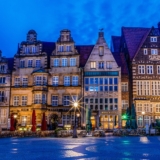Over time, humankind has tried to transform oral speech into written texts and has developed many writing forms along the way. From the old cuneiform to Egyptian hieroglyphs, Chinese ideograms, Semitic consonants and Latin letters, we have tried it all, or at least a great deal of it.

Cyrillic alphabet distribution
While in today’s world we consider the Latin alphabet to be a universal script and we transcribe everything if possible, people are still aware that others might write with different letters.
One of the other alphabets of which people have heard of is the Cyrillic one, partly because of the Cold War, partly because Russia is the only country that covers almost half of the known world and thus proves difficult to ignore.
The Cyrillic alphabet is the Slavic equivalent of the Latin alphabet, invented in the Middle Ages to suit the new Slavic languages. It has particularities that people who use the Latin one could find confusing, such as writing P and pronouncing R. You write Россия and read Russia.
Most of us know that if we travel to that part of the world we may confuse the names of our destinations and end up lost somewhere in Siberia, probably close to the Mongolian hoards of the Middle Ages, west to where the dragons live and near the shores of some yet undiscovered sea.
Most of us are afraid of those foreign places with foreign names and because of that fear we will try to get acquainted with Cyrillic in an intrigued attempt to know our enemy. But few of us are aware of just how overwhelming such a task might be, because…
and this is one of the secrets of Eastern Europe, the Silk Road and all those -stan ending countries
…there is not one Cyrillic alphabet but indeed, more than 20 Cyrillic script variants, all with their own additional letters.
You may go to remote Bulgaria and find out that Велико Търново / Veliko Tarnovo is a lovely town, then to Ukraine, where the Eastern steppes begin and see names like Львів / Lviv or Євпаторія / Yevpatoriya and wonder what you would call these towns back home.
Then you head north to White Russia (Belarus in translation) to the town of Заслаўе / Zaslawye and its lovely church, through the steppes again, finally reaching the old realm of Suzdal aka Moscow county with Москва, a rather famous capital. Here you may be greeted by bearded men in embroidered caftans, travelling in horse pulled slays, living in tsarist manors, with names you can’t pronounce and you haven’t even reached the Ural mountains.
Even more, you haven’t even left Europe yet!
But before you set forth beyond the Urals, there is still another ancient place of wonders to visit, the Caucasus. Nothing seems more romantic, more mysterious, more dangerous than the mountainous realm at the gate of Europe, or if you wish, from the dawn of Europe. The Caucasus is literally a linguistic mosaic and has been so since forgotten times.

Caucasian Landscape
These languages resemble no others on Earth, as they are older than most other languages on Earth, some are almost void of vowels, other use sounds unheard of anywhere else, but they write Cyrillic! Their own version of it.
There is Abkhaz Cyrillic, Adyghe Cyrillic, Kabardian Cyrillic, Avar Cyrillic, Lezghian Cyrillic, Chechen Cyrillic, Kumyk Cyrillic, Lak Cyrillic, Ossetian Cyrillic to name just a few.
When the traveller arrives here, there is no point in him trying to understand where he might be, how he would translate any place name or the languages he hears. It’s best to leave this particular endeavour in the hands of professional philologists, who already have a hard time discerning what exactly has happened here.
So after simply enjoying the mountain air, you head back towards the steppe and almost past the Urals. Almost is a key word, as before you cross over, you must first meet the last Finns of the Eurasian steppe: Komi, Mari, Mordvin and maybe visit the lovely town of Саранск or Saransk. They are related to the Finns of Finland, who originally came from here and now use their own Cyrillic alphabet.
From here, you finally go into the Beyond, Siberia and all those former USSR, -stan ending nations, but by now, one should be used to discover again and again the marvellous alphabet. You find it from Kazakhstan to Kyrgyzstan, to Uzbekistan and Turkmenistan, in infinite varieties if you are into this sort of thing.
If not, just visiting these places can be very nice, especially if one is interested in owning carpets. We recommend the bazaars of Самарканд or Samarkand.

Uzbek rug
You cannot find a better souvenir or one which would prepare yourself more for what’s coming next as we head towards sleeping Siberia and its arctic wilderness.
If you’ve ever wanted to go on a magic carpet ride, this is your chance, just bring your Uzbek or Turkmen newly bought rug to the Улан-Батор or Ulan Bator bound Trans-Siberian train. Be careful though, for the same train then goes further East, above the Arctic circle, at -40 degrees Celsius and the same in Fahrenheit, to the town of Якутск / Yakutsk and from there on to the spirit world and the end of the Earth.
These are the coldest and most remote places on Earth, where speaking is difficult and writing – optional, but if it weren’t, it would still be in Cyrillic!
So fly away on a magical reindeer across the hibernal oriental steppes, towards Владивосток / Vladivostok, the most Eastern shore, until the West begins across the strait to Alaska, or how it used to be written – Аляска.

A musk ox looking towards Alaska
If you are still alive by now, you will have learned a valuable lesson. Whether you are on a flying carpet or an enchanted reindeer, Cyrillic can be a formidable adventure. You may speak Bulgarian, Ukrainian, Russian, Chechen, Uzbek, Mongolian or any other language of the Siberian wilderness, but you will write Cyrillic.
Get off the magical reindeer or the flying carpet and have a vodka shot. You are a linguistic hero! На здоровье!
Photo Sources
- Veliko Tarnovo, Bulgaria: by glynniqua
- Caucasian landscape: by Morten Oddvik
- Musk ox








